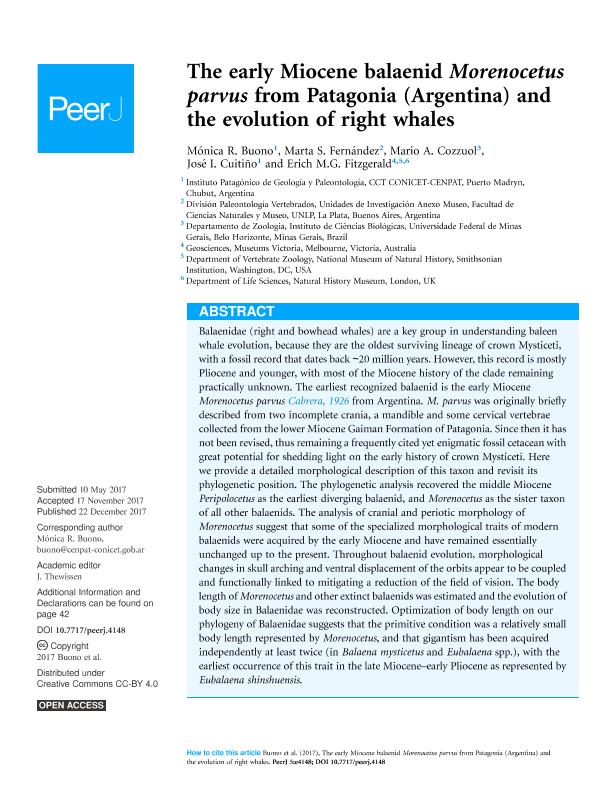Artículo
The early Miocene balaenid Morenocetus parvus from Patagonia (Argentina) and the evolution of right whales
Buono, Mónica Romina ; Fernández, Marta Susana
; Fernández, Marta Susana ; Cozzuol, Mario Alberto; Cuitiño, José Ignacio
; Cozzuol, Mario Alberto; Cuitiño, José Ignacio ; Fitzgerald, Erich M. G.
; Fitzgerald, Erich M. G.
 ; Fernández, Marta Susana
; Fernández, Marta Susana ; Cozzuol, Mario Alberto; Cuitiño, José Ignacio
; Cozzuol, Mario Alberto; Cuitiño, José Ignacio ; Fitzgerald, Erich M. G.
; Fitzgerald, Erich M. G.
Fecha de publicación:
12/2017
Editorial:
PeerJ
Revista:
PeerJ
ISSN:
2167-8359
Idioma:
Inglés
Tipo de recurso:
Artículo publicado
Clasificación temática:
Resumen
Balaenidae (right and bowhead whales) are a key group in understanding baleen whale evolution, because they are the oldest surviving lineage of crown Mysticeti, with a fossil record that dates back ~20 million years. However, this record is mostly Pliocene and younger, with most of the Miocene history of the clade remaining practically unknown. The earliest recognized balaenid is the early Miocene Morenocetus parvus Cabrera, 1926 from Argentina. M. parvus was originally briefly described from two incomplete crania, a mandible and some cervical vertebrae collected from the lower Miocene Gaiman Formation of Patagonia. Since then it has not been revised, thus remaining a frequently cited yet enigmatic fossil cetacean with great potential for shedding light on the early history of crown Mysticeti. Here we provide a detailed morphological description of this taxon and revisit its phylogenetic position. The phylogenetic analysis recovered the middle Miocene Peripolocetus as the earliest diverging balaenid, and Morenocetus as the sister taxon of all other balaenids. The analysis of cranial and periotic morphology of Morenocetus suggest that some of the specialized morphological traits of modern balaenids were acquired by the early Miocene and have remained essentially unchanged up to the present. Throughout balaenid evolution, morphological changes in skull arching and ventral displacement of the orbits appear to be coupled and functionally linked to mitigating a reduction of the field of vision. The body length ofMorenocetus and other extinct balaenids was estimated and the evolution of body size in Balaenidae was reconstructed. Optimization of body length on our phylogeny of Balaenidae suggests that the primitive condition was a relatively small body length represented by Morenocetus, and that gigantism has been acquired independently at least twice (in Balaena mysticetus and Eubalaena spp.), with the earliest occurrence of this trait in the late Miocene-early Pliocene as represented by Eubalaena shinshuensis.
Palabras clave:
Balaenidae
,
Evolution
,
Mysticeti
,
Neogene
,
Patagonia
Archivos asociados
Licencia
Identificadores
Colecciones
Articulos(CCT - LA PLATA)
Articulos de CTRO.CIENTIFICO TECNOL.CONICET - LA PLATA
Articulos de CTRO.CIENTIFICO TECNOL.CONICET - LA PLATA
Citación
Buono, Mónica Romina; Fernández, Marta Susana; Cozzuol, Mario Alberto; Cuitiño, José Ignacio; Fitzgerald, Erich M. G.; The early Miocene balaenid Morenocetus parvus from Patagonia (Argentina) and the evolution of right whales; PeerJ; PeerJ; 2017; 12; 12-2017; 1-48
Compartir
Altmétricas



